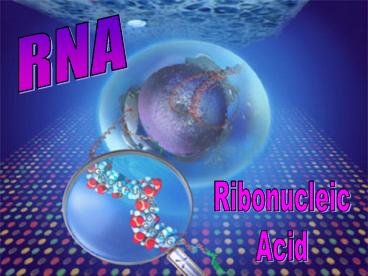RNA - PowerPoint PPT Presentation
1 / 11
Title: RNA
1
RNA
Ribonucleic Acid
2
Function of RNA
Genes are coded DNA instructions that control the
production of proteins
Since DNA cannot leave the nucleus, RNA molecules
will convert the written instructions into
proteins in the cytoplasm
3
Structure of RNA
RNA is a nucleic acid consisting of a long chain
of nucleotides
RNA Nucleotide
- Like all nucleotides, RNA nucleotides contain a
- 5-carbon sugar - ribose
- phosphate group
- nitrogenous base
4
Nitrogenous Bases of RNA
RNA nucleotides will contain one of four bases
Pyrimidines
Purine
Three of the four are the same as DNA guanine,
cytosine, and adenine but the base uracil
replaces thymine in RNA
5
Since uracil is a pyrimidine, it will bond with
the purine adenine
Base pairing rule in RNA
Base Pairing
A pairs with U C pairs with G
6
There are three main types of RNA involved in
protien synthesis
1 messenger RNA (mRNA)
Carries the message from DNA in the nucleus to
the ribosome in the cytoplasm
Types of RNA
2 transfer RNA (tRNA) Transfers amino acids in
the cytoplasm to the ribosome
3 ribosomal RNA (tRNA) Builds ribosomes along
with proteins
7
messenger RNA
8
transfer RNA
9
Ribosomal
RNA
10
Thats not all folks...
There are also many other types of RNA molecules
that are not directly involved in protein
synthesis. They are sometimes called noncoding RNA
ncRNA is involved in many other cell processes
including the regulation of transcription, DNA
replication and RNA processing and modification
Types of ncRNA
snRNA (short nuclear)
snoRNA (short nucleolar)
miRNA (micro)
siRNA (short interfering)
11
DNA RNA are alike in that they are both nucleic
acids composed of nucleotides, their differences
lie in their functions and structure
DNA vs. RNA































